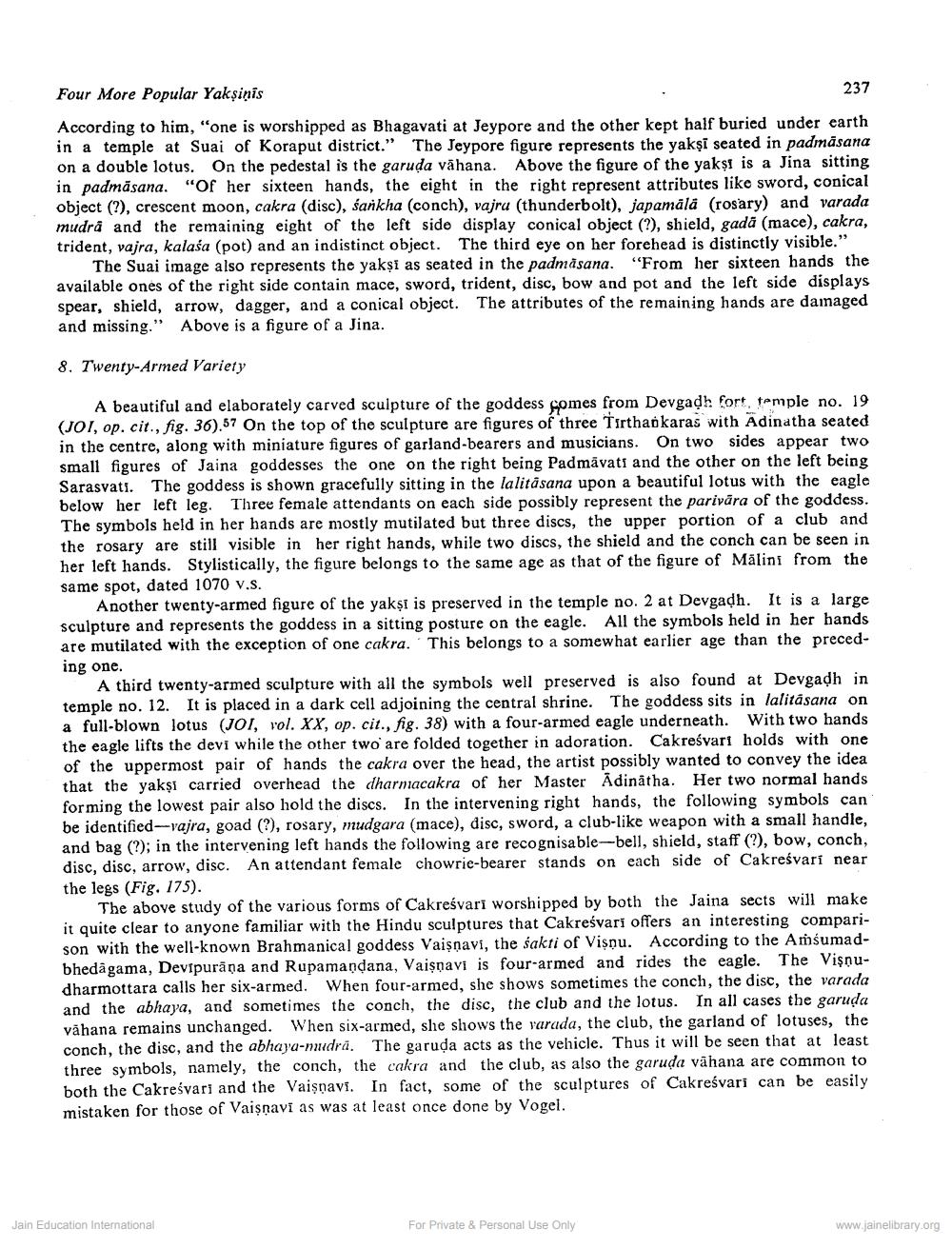________________
Four More Popular Yakșinis
237
According to him, "one is worshipped as Bhagavati at Jeypore and the other kept half buried under earth in a temple at Suai of Koraput district." "The Jeypore figure represents the yakşi seated in padmasana on a double lotus. On the pedestal is the garuda vähana. Above the figure of the yakşi is a Jina sitting in padmāsana. "Of her sixteen hands, the eight in the right represent attributes like sword, conical object (?), crescent moon, cakra (disc), sankha (conch), vajra (thunderbolt), japamälä (rosary) and varada mudra and the remaining eight of the left side display conical object (?), shield, gadā (mace), cakra, trident, vajra, kalasa (pot) and an indistinct object. The third eye on her forehead is distinctly visible."
The Suai image also represents the yakşi as seated in the padmasana. “From her sixteen hands the available ones of the right side contain mace, sword, trident, disc, bow and pot and the left side displays spear, shield, arrow, dagger, and a conical object. The attributes of the remaining hands are damaged and missing." Above is a figure of a Jina.
8. Twenty-Armed Variety
A beautiful and elaborately carved sculpture of the goddess gomes from Devgadh fort, temple no. 19 (JOI, op. cit., fig. 36).57 On the top of the sculpture are figures of three Tirtha karas with Adinatha seated in the centre, along with miniature figures of garland-bearers and musicians. On two sides appear two small figures of Jaina goddesses the one on the right being Padmavati and the other on the left being Sarasvati. The goddess is shown gracefully sitting in the lalitâsana upon a beautiful lotus with the eagle below her left leg. Three female attendants on each side possibly represent the parivāra of the goddess. The symbols held in her hands are mostly mutilated but three discs, the upper portion of a club and the rosary are still visible in her right hands, while two discs, the shield and the conch can be seen in her left hands. Stylistically, the figure belongs to the same age as that of the figure of Mālini from the same spot, dated 1070 v.s.
Another twenty-armed figure of the yakşi is preserved in the temple no. 2 at Devgadh. It is a large sculpture and represents the goddess in a sitting posture on the eagle. All the symbols held in her hands are mutilated with the exception of one cakra. This belongs to a somewhat earlier age than the preceding one.
A third twenty-armed sculpture with all the symbols well preserved is also found at Devgadh in temple no. 12. It is placed in a dark cell adjoining the central shrine. The goddess sits in lalitásana on a full-blown lotus (JOI, vol. XX, op. cit., fig. 38) with a four-armed eagle underneath. With two hands the eagle lifts the devi while the other two are folded together in adoration. Cakreśvari holds with one of the uppermost pair of hands the cakra over the head, the artist possibly wanted to convey the idea that the yakși carried overhead the dharmacakra of her Master Adinatha. Her two normal hands forming the lowest pair also hold the discs. In the intervening right hands, the following symbols can be identified-vajra, goad (?), rosary, mudgara (mace), disc, sword, a club-like weapon with a small handle, and bag (?); in the intervening left hands the following are recognisable-bell, shield, staff (?), bow, conch, disc, disc, arrow, disc. An attendant female chowrie-bearer stands on each side of Cakreśvari near the legs (Fig. 175).
The above study of the various forms of Cakreśvari worshipped by both the Jaina sects will make it quite clear to anyone familiar with the Hindu sculptures that Cakreśvari offers an interesting comparison with the well-known Brahmanical goddess Vaisnavi, the sakti of Vişnu. According to the Amśumadbhedagama, Devipurāna and Rupamandana, Vaişnavi is four-armed and rides the eagle. The Vişnudharmottara calls her six-armed. When four-armed, she shows sometimes the conch, the disc, the varada and the abhaya, and sometimes the conch, the disc, the club and the lotus. In all cases the garuda vāhana remains unchanged. When six-armed, she shows the varada, the club, the garland of lotuses, the conch, the disc, and the abhaya-mudra. The garuda acts as the vehicle. Thus it will be seen that at least three symbols, namely, the conch, the cakra and the club, as also the garuda vāhana are common to both the Cakreśvari and the Vaisnavi. In fact, some of the sculptures of Cakreśvari can be easily mistaken for those of Vaisnavi as was at least once done by Vogel.
Jain Education International
For Private & Personal Use Only
www.jainelibrary.org




